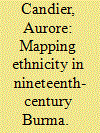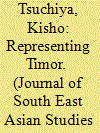|
|
|
Sort Order |
|
|
|
Items / Page
|
|
|
|
|
|
|
| Srl | Item |
| 1 |
ID:
168576


|
|
|
|
|
| Summary/Abstract |
This article examines gotong royong as social citizenship in the second half of the twentieth century in Indonesia. Gotong royong was traditionally understood as a collective spirit among neighbours to strengthen economic and social resilience. However, the institutionalisation of the system through massive development programmes since the 1940s has influenced the common people's perception and practice of it. This article argues that the co-option of gotong royong as part of the discourse of nation-state building transformed the popular view of labour and capital mobilisation from an openly critical stance to apparent submission. Gotong royong became a means of social engineering and an ingenious linguistic strategy by which state elites orchestrated control over the making of citizens. Still, Indonesians have remained vigilant of their participation in gotong royong, and about the potential for its misuse by corrupt officials.
|
|
|
|
|
|
|
|
|
|
|
|
|
|
|
|
| 2 |
ID:
168573


|
|
|
|
|
| Summary/Abstract |
The Aru Islands in southeastern Maluku have a long history of economic exchange and colonial relations with the Dutch East India Company (VOC), and later the Dutch colonial state. Aru was fragmented in smaller autonomous settlements, of which those in the east produced valuable items for export, such as pearls and tripang (edible sea cucumber). The article focuses on a spate of anti-colonial revolts in the waning days of the VOC in the 1790s. It centred on the Batuley villages situated on a few small islands on the eastern side. The central incident leading to the resistance was the killing of a Dutch low-ranking officer, Scheerder, an event which has been preserved in local tradition till the present day. A search in the VOC archives confirms several details, but suggests a rationale for the resistance which is partly different from the traditional version, and linked in with larger movements of resistance in Aru and Maluku. The article discusses the significance of the oral traditions, and how a comparison with archival materials can enrich our understanding of Arunese–Dutch relations.
|
|
|
|
|
|
|
|
|
|
|
|
|
|
|
|
| 3 |
ID:
168579


|
|
|
|
|
| Summary/Abstract |
This volume contains an introduction and eight papers presented at an international symposium ‘Let's Talk about Trees’, which was organised by Ritsuko Kikusawa and hosted by the National Museum of Ethnology of Osaka, Japan, in February 2013. The stated purpose of the meeting was to evaluate the pros and cons of the classic tree model of historical linguistics in describing the order of splits within a language family. Because the problem of modelling relationships of descent is common to other disciplines, contributors were invited from a range of academic disciplines, including not only linguistics, but also what is described on page one as ‘cladistics’, ‘biology’ and ‘genetics’, although cladistics is clearly a part of biological taxonomy, and not an independent discipline.
|
|
|
|
|
|
|
|
|
|
|
|
|
|
|
|
| 4 |
ID:
168577


|
|
|
|
|
| Summary/Abstract |
We argue in this article that the social and economic conditions in the Angkorian society of the tenth century or earlier contributed to the decline in status of some middle-level officials, as is evident from the mid-eleventh century. Many Angkorian inscriptions written between the late ninth and late twelfth centuries record purchases and donations of lands acquired for religious foundations. The texts often contain details of transactions and disputes seeking to validate title to these holdings. The buyers include middle-ranking loñ and vāp, and increasingly, higher-ranking officials. An analysis of the roles and activities of the officials reveals something of their relative status and helps explain the disappearance of vāp from the inscriptions in the eleventh century, and the relegation of loñ to temple roles by the twelfth century. The transfer of communal lands and lands owned by these officials to elites is attributed to hierarchical restrictions on land purchases, a reduction in fiscal immunities, and the need for taxes to be paid to the centre with high-value goods in Angkor's moneyless economy.
|
|
|
|
|
|
|
|
|
|
|
|
|
|
|
|
| 5 |
ID:
168574


|
|
|
|
|
| Summary/Abstract |
Successive wars and the establishment of a border between the kingdom of Burma and British India in the nineteenth century challenged Burmese conceptions of sovereignty and political space. This essay investigates how European, and more specifically Anglo-American, notions of race, nation, and consular protection to nationals, progressively informed the Burmese concepts of ‘categories of people’ (lumyo) and ‘subject’ (kyun). First, I present the semantic evolution of these concepts in the 1820s–1830s, following the annexation of the western Burmese province of Arakan by British India in 1824. Then, I argue that the Burmese concept of lumyo was progressively associated with the European concept of ‘nations’ in the 1850s–1860s, following the annexation of Lower Burma in 1852. Finally, I uncover developments in the 1870s, when British consular protection extended to several freshly categorised ‘nations’, such as Shan, Karenni, and Kachin.
|
|
|
|
|
|
|
|
|
|
|
|
|
|
|
|
| 6 |
ID:
168578


|
|
|
|
|
| Summary/Abstract |
Lord Reid played a vital role as chairman in a Commonwealth commission in framing the Malayan Independence constitution between 1956 and 1957. The Scottish Lord of Appeal sought to ensure the commission's impartiality and to achieve a fair balance between the demands of the various interest groups. The Federation of Malaya was a complex emerging nation-state with a diverse population and the framers had to manage competing interests and demands. This article, through a close examination of the primary constitutional documents, considers Reid's influence on the framing of the Malayan (and hence, Malaysian) federal constitution. The article begins with a brief discussion of Lord Reid's appointment to head the commission and then considers in some depth areas where his influence on the framing of the draft constitution is evident. The article argues that Reid was the main playmaker and moderator during the constitution-framing process and played a critical role in ensuring a balance was achieved between the competing demands of the federal government and the states, safeguarding the fundamental rights of the citizens against the state, and in moderating the various communal demands.
|
|
|
|
|
|
|
|
|
|
|
|
|
|
|
|
| 7 |
ID:
168575


|
|
|
|
|
| Summary/Abstract |
This article provides an outline of the historical construction of Timorese (East Timorese and Indonesian West Timorese) geo-bodies and communal identities from the mid-nineteenth century to the present time, thereby reconstructing the origins of many national imaginings amongst the Timorese people. Since the controversial annexation of Portuguese Timor by Indonesia in 1976, (East) Timor has been constructed as a place of two territorial identities: Timor as a part of Indonesia and East Timor as a homogeneous nation distinct from Indonesia. However, representations of Timor had been much more fluid and inconsistent in preceding ages. This article studies various communities’ representations of Timor to reveal dialectic relations between diverse colonial and post-colonial representations of the Timorese spaces and their senses of belonging. Thereby, it problematises the political role of global and regional place-making in a contested Southeast Asian locale.
|
|
|
|
|
|
|
|
|
|
|
|
|
|
|
|
|
|
|
|
|